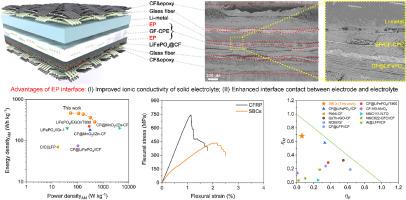In-situ-interface-engineered mechanically robust solid polymer electrolyte for carbon fiber reinforced structural battery composites
IF 9.8
1区 材料科学
Q1 MATERIALS SCIENCE, COMPOSITES
引用次数: 0
Abstract
Carbon fiber structural battery composites (SBCs), which integrate energy storage and load-bearing functions, hold significant promise for vehicle weight reduction. This work developed strategies based on interfacial engineering to design and construct a deep eutectic polymer electrolyte (EP) at the electrode/glass fiber reinforced composite polymer electrolyte (GF-CPE) interface, which effectively enhances ionic conductivity of GF-CPE and improves the stability of the electrode/electrolyte interface. Therefore, the mechanically robust EP/GF-CPE (Young's modulus of 1.5 GPa) achieved an ionic conductivity of 0.41 mS cm−1 with a high ion transference number (0.77). The Li//EP/GF-CPE//Li symmetric cell also demonstrated stable cycling performance for 1500 h at 0.5 mA cm−2. Furthermore, the in-situ interfacial engineered EP/GF-CPE enabled carbon fiber LiFePO4//EP/GF-CPE//Li SBCs to attain a high energy density of 466.8 Wh kg−1 based on active materials and 28.0 Wh kg−1 based on the mass of whole device. Regarding cyclic durability, the structural battery preserves 90.5 % of its capacity after undergoing 1000 cycles. It concurrently demonstrates mechanical robustness with a flexural strength value of 348.6 MPa and a flexural modulus of 29.7 GPa. Comprehensive in-situ electrochemical-mechanical testing offers confirmatory evidence of the structural battery's capacity to preserve electrochemical functionality and structural integrity when subjected to diverse mechanical loading scenarios. A prototype solar storage charging integrated system powering a boat model further showcased the multifunctionality of the structural batteries. This work highlights that interfacial engineering is a feasible and effective strategy for developing high-performance multifunctional carbon fiber structural batteries.

碳纤维增强结构电池复合材料的原位界面工程机械坚固固体聚合物电解质
碳纤维结构电池复合材料(sbc)集储能和承载功能于一体,在汽车减重方面前景广阔。本工作基于界面工程的方法,在电极/玻璃纤维增强复合聚合物电解质(GF-CPE)界面处设计并构建了深度共晶聚合物电解质(EP),有效提高了GF-CPE的离子电导率,提高了电极/电解质界面的稳定性。因此,机械坚固的EP/GF-CPE(杨氏模量为1.5 GPa)的离子电导率为0.41 mS cm - 1,离子转移数高(0.77)。Li//EP/GF-CPE//Li对称电池在0.5 mA cm−2下也表现出1500 h的稳定循环性能。此外,原位界面工程EP/GF-CPE使碳纤维LiFePO4//EP/GF-CPE//Li sbc获得了基于活性材料的466.8 Wh kg−1和基于整个设备质量的28.0 Wh kg−1的高能量密度。在循环耐久性方面,经过1000次循环后,结构电池保留了90.5%的容量。同时,其抗弯强度值为348.6 MPa,抗弯模量为29.7 GPa,具有良好的机械鲁棒性。全面的现场电化学-力学测试提供了确凿的证据,证明了结构电池在各种机械载荷情况下保持电化学功能和结构完整性的能力。一个为船模型供电的太阳能存储充电集成系统原型进一步展示了结构电池的多功能。本研究强调界面工程是开发高性能多功能碳纤维结构电池的一种可行和有效的策略。
本文章由计算机程序翻译,如有差异,请以英文原文为准。
求助全文
约1分钟内获得全文
求助全文
来源期刊

Composites Science and Technology
工程技术-材料科学:复合
CiteScore
16.20
自引率
9.90%
发文量
611
审稿时长
33 days
期刊介绍:
Composites Science and Technology publishes refereed original articles on the fundamental and applied science of engineering composites. The focus of this journal is on polymeric matrix composites with reinforcements/fillers ranging from nano- to macro-scale. CSTE encourages manuscripts reporting unique, innovative contributions to the physics, chemistry, materials science and applied mechanics aspects of advanced composites.
Besides traditional fiber reinforced composites, novel composites with significant potential for engineering applications are encouraged.
 求助内容:
求助内容: 应助结果提醒方式:
应助结果提醒方式:


